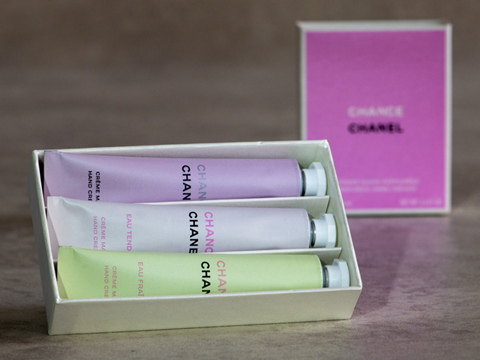
The ‘world’s smallest’ child-resistant tube from Hoffmann Neopac, Chanel and L’Occitane’s hand cream tubes with octagonal caps, and lightweight, recyclable closures from Albéa are among the winners of etma’s Tube of the Year 2024 Award.
A seven-member jury consisting of the association’s members voted at etma’s annual conference in Warsaw on 23rd May 2024.
In the aluminium tube category, Tubex Aluminium Tubes was awarded the prize for a limited-edition set of three Chanel hand creams. Based on the Chance, Chance Eau Fraiche, and Chance Eau Tendre fragrances, the hand cream tubes are decorated in a pastel shade intended to reflect each scent, with a pearlescent finish and octagonal closure implemented for a premium aesthetic.
Chanel has selected Tubex’s Blue Tube Evo, which claims to have been the ‘world’s first’ tube made of 100% recycled aluminium. Containing 95% post-consumer recycled content, it is believed to be infinitely recyclable and reduce carbon emissions ‘significantly’.
The creams are distributed in a ‘sleek’ box containing all three scents.
Another hand cream tube collaboratively developed by L’Occitane and Albéa was chosen in the laminate tube category. This time, the 30ml bottles of L’Occitane’s shea butter hand cream have transitioned away from an aluminium barrier laminate design into a Greenleaf tube, an APR-certified multilayer sleeve in HDPE.
Albéa’s OctoTop, a two-in-one flip-top closure system with another octagonal shape, has replaced the previous peel seal. Combined with the Greenleaf sleeve, the number of materials utilized has apparently been cut from five down to one, and the components from three to two – a move said to lower the weight by 23% while ensuring its compatibility with French, European, and American recycling streams.
Another Albéa tube was awarded in the plastic tube category. Its mono-material PCR Max tube has been applied to Decathlon’s Active Solaire Sun SPF50 suncream product, with 70% post-consumer recycled material integrated into the sleeve.
Combined with the manufacturers EcoFusion top, the pack is set to be 80% lighter than a standard head and cap solution, and it is designed for recycling in the HDPE recycling stream.
Hoffmann Neopac was the winner in the prototype category with the ‘world’s smallest’ child-resistant tube. Designed to negate the need for additional blisters, the high-barrier tube comes with a 10mm diameter and a 0.30 wall thickness for 0.4ml – 2ml products.
The pack is produced under ISO 8 cleanroom conditions, according to Hoffmann Neopac, and targets the pharmaceutical and consumer and animal health sectors. A coloured tube body, low-migration offset print, and varnishing are all listed as decorative options.
Its cap is made from a composition of PE/POM. Its child resistance is tested in line with US 16 CFR § 1700.20 and EU ISO 8317 standards. A dropper insert can also be applied for products that require precise dosing.
The top prize in the sustainability category was awarded to Albéa’s EcoLittle Top Tube, applied to premium skincare brand Clarins. The flip-top EcoLittle Top system is made of post-consumer recycled PE and HDPE, which reduces the amount of virgin plastics needed to manufacture the closure and ensures its recyclability in HDPE streams.
It is said to contain 45% recycled material – and, in a move claimed to reduce the tube’s weight by 47%, removes a single component from standard flip-top closure designs.
“European tube manufacturers have once again demonstrated their strong innovative strength and creativity in this year’s competition,” said Gregor Spengler, secretary general at etma. “This is demonstrated not least by the large number of tubes submitted for the competition in the prototypes category.
“I am particularly pleased about this, as I see it as an indicator of the wealth of ideas of our member companies, which is a guarantee for the future viability of tubes as a packaging material.
“Our globally recognized “Tube of the Year” competition is always an internationally renowned benchmark and trend indicator for current and future developments in the tube industry. Unsurprisingly, sustainable and resource-efficient packaging solutions are still at the centre of the competition.
“In particular, improved recyclability, further material reductions and the increased use of recycled materials should be mentioned here. However, smaller tube formats are also in vogue, reflecting social developments such as rising mobility and the trend towards single households.
“And in view of all these aspects, the tube is increasingly proving to be the tailor-made and contemporary packaging of the future.”
The news comes after etma reported that its manufacturers’ tube deliveries had reached a total of just under 11.9 billion units in 2023 – meaning that, despite adverse conditions, the figure had remained stable compared to 2022.
Additionally, Stina Inc.’s Tube Recycling Project is said to have reached a ‘critical design milestone’ in HDPE squeeze tube recycling, with 75% of all HDPE plastic squeeze tubes on the US market thought to be compatible with the colour HDPE bottle recycling stream. It has shared its findings on a new website.
If you liked this story, you might also enjoy:
How are the top brands progressing on packaging sustainability?
The ultimate guide to global plastic sustainability regulation











No comments yet